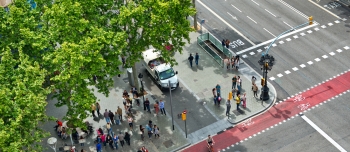CLOSER CITIES aims to create a bridge between urban science and urban practice. By collecting cases on urban practice, analysing them on the shoulders of urban science and sharing research outcomes, urban knowledge becomes shareable. In the ‘5 questions’ series, we ask scientists to briefly reflect on their research and the shareability of their insights and projects.
1. What is the main focus of your research (topic, theme, region)?
[Visible Cities: Place Branding Role for an Inclusive Urban Development in Saudi Cities]
2. Can you give a brief description of your research?
The kingdom of Saudi Arabia (KSA) has bright opportunities to influence the world-wide capitalism by opening up to market and go through ambitious spatial development as prescribed in the 2030 Vision and its programs. The new spatial planning strategy for KSA (NSS 2030) emphasizes clearly transforming the traditional state-based development practices into an open market-oriented development by incorporating all stakeholders and making Saudi cities more attractive to business owners and investors. Keeping all this in mind, this thesis wants to investigate place branding phenomenon, which is using branding strategies and concepts and its potentiality to make a sustainable place to overcome the traditional physical planning setbacks. More Precisely, the thesis examines place branding role and contribution to the inclusive urban transformation, special reference would be made to the eastern province of Saudi Arabia. For the main strand of reasoning of this thesis, it will critically investigate the potential or actual roles of place branding as tool for attaining inclusive urban development targets for Saudi cities.
3. How much influence does ‘local context’ have in your field of work? Can results or solutions from your research be shared with other regions easily?
It is believed that literature of destination branding almost has not taken Saudi Arabia, Saudi regions or cities as case studies. Hence, this PhD would contribute to the literature of destination branding globally as well as in the practice by developing experimental evidence of Saudi regions. Moreover, most of the limited literature of the place branding in the Saudi context have dealt with tourism and business approach and omitting the other geographical scale and more oriented to urban planning approach. Such direction can bring unique components of a place into focus, which improbable to occur in corporate branding approach. Exploratory perception of this thesis plan to deliver regarding the position of destination branding as a tool for attaining inclusive urban development. Consequently, to filling the gap literature by shifting the place branding process toward sustainable and inclusive approaches in Saudi Arabia and elsewhere.
4. What are the main lessons learned that can be used by urban initiatives?
- Depending on urban development policy only is not sufficient to tackle challenges of urban development, to build civic pride and a sense of place to its current users, or to bring new residents, investors, businesses, or tourists. Whereas, depending on place branding only is not sufficient for urban development, except if the former integrates with urban development as a tool.
- Excluding branding approach in the urban development process may lead to rise economic risks, while including branding perspective would make the urban development strategies more stable and impactful.
- As the aim of branding campaigns is functioning as an influential political remedy to urban challenges, it often led in certain cases to gentrification. This result occurs as a consequence of simply relocates the low-income group and their associated issues to other areas and encouraging social elites.
- There are a substantial number of cities that brand themselves with the concept of green development such as eco-city, green city, and low-carbon city. While these brands look appealing for the creative class, it is believed that it may lead to overstating green ambitions as well as remarkable income inequalities.
- The practice of place branding is developed to work adequately in countries that the public participation process is taking a vital part in planning systems. Which can make the policy of place branding a problematic in the developing countries that are adopting a top-down approach, and where the cooperation between private sectors and the government is fragmented along with remarkable stakeholder exclusion.
- The exclusion of local stakeholders will make the brands to concentrate on the elements that go hand in hand with global and international criteria such as physical parts as a way of positioning their cities regarding current global cities.
- Place branding is being deeply influenced by the framework that is defined by the national government Five-Year plan. Consequently, national values might be flourished, however, local values and stakeholders would be excluded, and local commitment to the place branding strategy could be negatively affected.
5. How do you think cities can implement these lessons?
- Place branding could be more inclusive whenever it is being utilised as a tool to reshape the city rather than adopting it as a communicative platform.
- Place branding as an urban development tool can provide a reliable new route to the places that can handle and effective reaction to social imbalances, macroeconomic unevenness, general economic, and unemployment.
- Place branding can represent the connection between the citizens and the government and the relationship between the user and the places. hence, branding activities to places can be interpreter as communicative instrument according to the seminal work of Christopher Hood (1983). Which he introduced four policy instruments:).
- Although place promotion, marketing, and branding have different features and effectiveness, all of them belong to the same type of instrument, which is a communicative or 'nodality' instruments. However, there is a significant challenge of making all the four types of policies which used by municipalities to move in the same direction: communitive (Nodality), Authority, Treasure and Organisation (NATO). The homogeneous of these policies can give place branding a good place in the planning system and maintain its competency.











